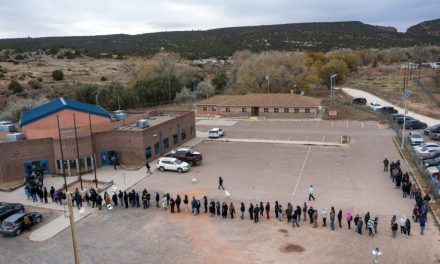Left: Hayward L. Oubre, Jr. (American, 1916–2006), Wilted, oil on canvas, 40 ⅛ x 24 in., The
Johnson Collection, Spartanburg, South Carolina. Right: Hayward L. Oubre, Jr. (American, 1916–2006), Pensive Family, oil on canvas, 38 x 24 in., Larry D. and Brenda A. Thompson Collection.
” data-medium-file=”https://www.birminghamtimes.com/wp-content/uploads/2024/10/3-Pl.14_Johnsonpress_JOIN-300×248.jpg” data-large-file=”https://www.birminghamtimes.com/wp-content/uploads/2024/10/3-Pl.14_Johnsonpress_JOIN-1024×846.jpg” tabindex=”0″ role=”button” />
By Javacia Harris Bowser | For The Birmingham Times
Football and fine art may seem like an unlikely pair, but the Birmingham Museum of Art is going to show that the two can go together with a special Exhibition Opening Celebration to kick off Magic City Classic Week.
Set for October 20, this event will highlight the opening of two exhibitions: Hayward Oubre: Structural Integrity and Determined to Be: The Sculpture of John Rhoden. But this won’t be your average art show opening. The event will feature food trucks, face painting and live entertainment, including a warm welcome from the Lawson State Cheer Squad, a performance by Miles College Choir, and a drumline experience.
Because both Oubre and Rhoden have ties to Alabama historically Black colleges and universities (HBCUs), the team at the BMA see these exhibitions as an artistic homecoming that deserves as much fanfare as the state of Alabama gives to football. Rhoden attended Talladega College, and Oubre established the art department at Alabama State University.
“For two artists with deep HBCU legacies, it felt fitting to open their exhibitions during Magic City Classic Week,” said Katelyn D. Crawford, The William Cary Hulsey Curator of American Art at the BMA. “Oubre played football at Dillard University, so I think he would be especially excited about the connection.”
Structural Integrity
” data-medium-file=”https://www.birminghamtimes.com/wp-content/uploads/2024/10/6-Pl.31_BMA-1press-222×300.jpg” data-large-file=”https://www.birminghamtimes.com/wp-content/uploads/2024/10/6-Pl.31_BMA-1press-756×1024.jpg” tabindex=”0″ role=”button” class=”wp-image-123725 size-large” src=”https://www.birminghamtimes.com/wp-content/uploads/2024/10/6-Pl.31_BMA-1press-756×1024.jpg” alt=”” width=”640″ height=”867″ srcset=”https://www.birminghamtimes.com/wp-content/uploads/2024/10/6-Pl.31_BMA-1press-756×1024.jpg 756w, https://www.birminghamtimes.com/wp-content/uploads/2024/10/6-Pl.31_BMA-1press-222×300.jpg 222w, https://www.birminghamtimes.com/wp-content/uploads/2024/10/6-Pl.31_BMA-1press-768×1040.jpg 768w, https://www.birminghamtimes.com/wp-content/uploads/2024/10/6-Pl.31_BMA-1press-1134×1536.jpg 1134w, https://www.birminghamtimes.com/wp-content/uploads/2024/10/6-Pl.31_BMA-1press-1512×2048.jpg 1512w, https://www.birminghamtimes.com/wp-content/uploads/2024/10/6-Pl.31_BMA-1press-310×420.jpg 310w, https://www.birminghamtimes.com/wp-content/uploads/2024/10/6-Pl.31_BMA-1press-640×867.jpg 640w, https://www.birminghamtimes.com/wp-content/uploads/2024/10/6-Pl.31_BMA-1press-681×922.jpg 681w, https://www.birminghamtimes.com/wp-content/uploads/2024/10/6-Pl.31_BMA-1press.jpg 1772w” sizes=”(max-width: 640px) 100vw, 640px” />
Hayward Oubre: Structural Integrity opened at the BMA on Oct. 4, 2024, and will run through Feb. 2, 2025. Through 52 sculptures, paintings, and prints, the exhibition shows how Oubre (1916- 2006) shaped American art while working in the South and highlights the critical role of Black artists and art departments in creating the landscape of 20th century art.
“The Hayward Oubre exhibition was inspired by the museum’s purchase of a sculpture by Oubre, Bongo Drummer, in 2020,” Crawford explained. “After researching Oubre’s life and legacy, it became clear that his work needed to be brought together to tell a fuller history of Alabama art.”
Born in New Orleans in 1916, Oubre made history as the first student to earn a bachelor’s degree in fine arts from Dillard University, Louisiana’s oldest HBCU. After serving in World War II, he went on to attend the University of Iowa, where he earned his master’s degree in fine arts in 1948.
wire on wood base, 41 ⅝ x 17 ¼ x 22 in., The Johnson Collection, Spartanburg, South
Carolina.
” data-medium-file=”https://www.birminghamtimes.com/wp-content/uploads/2024/10/5-Pl.37_Johnsonpress-177×300.jpg” data-large-file=”https://www.birminghamtimes.com/wp-content/uploads/2024/10/5-Pl.37_Johnsonpress-605×1024.jpg” tabindex=”0″ role=”button” class=”wp-image-123724 ” src=”https://www.birminghamtimes.com/wp-content/uploads/2024/10/5-Pl.37_Johnsonpress-605×1024.jpg” alt=”” width=”295″ height=”500″ srcset=”https://www.birminghamtimes.com/wp-content/uploads/2024/10/5-Pl.37_Johnsonpress-605×1024.jpg 605w, https://www.birminghamtimes.com/wp-content/uploads/2024/10/5-Pl.37_Johnsonpress-177×300.jpg 177w, https://www.birminghamtimes.com/wp-content/uploads/2024/10/5-Pl.37_Johnsonpress-768×1299.jpg 768w, https://www.birminghamtimes.com/wp-content/uploads/2024/10/5-Pl.37_Johnsonpress-908×1536.jpg 908w, https://www.birminghamtimes.com/wp-content/uploads/2024/10/5-Pl.37_Johnsonpress-1211×2048.jpg 1211w, https://www.birminghamtimes.com/wp-content/uploads/2024/10/5-Pl.37_Johnsonpress-248×420.jpg 248w, https://www.birminghamtimes.com/wp-content/uploads/2024/10/5-Pl.37_Johnsonpress-640×1082.jpg 640w, https://www.birminghamtimes.com/wp-content/uploads/2024/10/5-Pl.37_Johnsonpress-681×1152.jpg 681w, https://www.birminghamtimes.com/wp-content/uploads/2024/10/5-Pl.37_Johnsonpress.jpg 1419w” sizes=”(max-width: 295px) 100vw, 295px” />
Oubre gained recognition for his creative use of a simple, everyday material—wire coat hangers. His modernist pieces blended his personal experiences, diverse interests, and art history influences, showcasing styles that spanned from realistic to fully abstract. Before the early 1980s, when he could no longer make the physically demanding sculptures, he completed nearly forty wire sculptures. While most art lovers know him for his work as a sculptor and printmaker, Oubre also painted throughout his career, exploring different materials and portraying the Black experience in his art.
“From vivid and assertive canvases that seem to announce themselves as visual declarations, to intricate and colorful wire sculptures that achieve new heights for the medium in his expert hands, Oubre’s work both captivates and fascinates,” said Graham C. Boettcher, R. Hugh Daniel Director and CEO of the Birmingham Museum of Art. “The BMA is proud to organize the first major monographic exhibition of his work and play a role in bringing his genius to a wider audience.”
Oubre’s influence on the art world extended beyond his work as a groundbreaking artist—he was also a respected educator. He became the first chair of the art department at Alabama State University (ASU) in Montgomery, a role he held from 1949 to 1965. Afterward, he went on to establish the art department at Winston-Salem State University (WSSU) in North Carolina, continuing the legacy he began at ASU. By dedicating his career to teaching in the South, Oubre played a key role in nurturing a growing community of Black artists in the region.
“When he retired in 1981, he had taught and made art for more than forty years, educating generations of Black southern artists,” said Crawford, who described Oubre’s work as “funny and current, relevant and visually dynamic, as well as political and personal.”
Structural Integrity will showcase the most outstanding pieces from Oubre’s body of work, covering topics including his training, teaching, and exhibiting at HBCUs; the influence of his military service on his art; his political activism during the Civil Rights Movement; and his fascination with modern technology, the Atomic Age, and the Space Race.
“Within Oubre’s story is a history of Alabama art shaping American art that has yet to be written,” Crawford said. “This exhibition begins to tell this story, laying the foundation for future projects on the work of Black artists in the South.”
” data-medium-file=”https://www.birminghamtimes.com/wp-content/uploads/2024/10/2019_27_3_04_Three-headed-lion-300×200.jpg” data-large-file=”https://www.birminghamtimes.com/wp-content/uploads/2024/10/2019_27_3_04_Three-headed-lion-1024×681.jpg” tabindex=”0″ role=”button” class=”wp-image-123732 size-full” src=”https://www.birminghamtimes.com/wp-content/uploads/2024/10/2019_27_3_04_Three-headed-lion.jpg” alt=”” width=”1200″ height=”798″ srcset=”https://www.birminghamtimes.com/wp-content/uploads/2024/10/2019_27_3_04_Three-headed-lion.jpg 1200w, https://www.birminghamtimes.com/wp-content/uploads/2024/10/2019_27_3_04_Three-headed-lion-300×200.jpg 300w, https://www.birminghamtimes.com/wp-content/uploads/2024/10/2019_27_3_04_Three-headed-lion-1024×681.jpg 1024w, https://www.birminghamtimes.com/wp-content/uploads/2024/10/2019_27_3_04_Three-headed-lion-768×511.jpg 768w, https://www.birminghamtimes.com/wp-content/uploads/2024/10/2019_27_3_04_Three-headed-lion-632×420.jpg 632w, https://www.birminghamtimes.com/wp-content/uploads/2024/10/2019_27_3_04_Three-headed-lion-640×426.jpg 640w, https://www.birminghamtimes.com/wp-content/uploads/2024/10/2019_27_3_04_Three-headed-lion-681×453.jpg 681w” sizes=”(max-width: 1200px) 100vw, 1200px” />
Determined to Be
Determined to Be: The Sculpture of John Rhoden is a homecoming for this artist’s works in more ways than one. Not only was Rhoden born and raised in Birmingham, but the BMA presented Rhoden’s first solo museum exhibition in 1985.
“The Birmingham Museum of Art is excited to welcome back this important artist with a retrospective show,” Boettcher said.
The show, which was organized by the Philadelphia Academy of Fine Arts, opens at the BMA on October 19, 2024, and will run through April 20, 2025.
“When I heard that the Pennsylvania Academy of the Fine Arts was organizing a John Rhoden exhibition, I knew we had to showcase this native son’s work in his hometown,” Crawford said.
Rhoden’s sculptural style was shaped by his wide-ranging travels, a deep appreciation for sensual forms, and a variety of visual influences, making his work truly ahead of its time. This exhibition — showcasing around fifty sculptures in bronze, wood, and stone — highlights the incredible visual and technical skill of this acclaimed artist.
Rhoden attended Industrial High School (now A. H. Parker High School) in Birmingham before going to Talladega College. In 1938, Rhoden moved to New York City where he studied at Columbia University and the New School for Social Research before launching into a sculpture career that took him around the world. He was the first Black visual artist fellow at American Academy of Rome, exhibited at the Metropolitan Museum of Art and Whitney Museum of Art, and won major awards including the Tiffany Award for Sculpture and the Rome Prize.
He is responsible for important public commissions throughout the United States and in Birmingham, where his sculpture of the Rev. Fred Shuttlesworth stands outside the Birmingham Civil Rights Institute.
About 18 pieces from the exhibition will remain in the BMA’s permanent collection. This gift from the Rhoden Estate will ensure that his legacy continues to be celebrated in his hometown art museum.
Exhibition Opening Celebration is set for Sunday, October 20, 1 to 5 p.m., at the Birmingham Museum of Art, 2000 Rev. Abraham Woods, Jr. Blvd, Birmingham, AL 35203. The event is free and open to the public.











